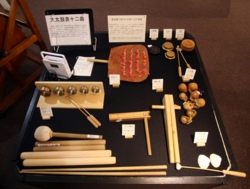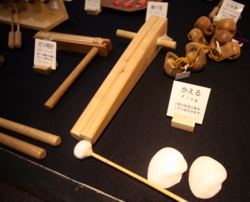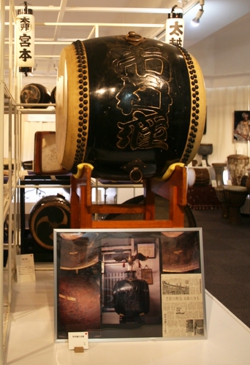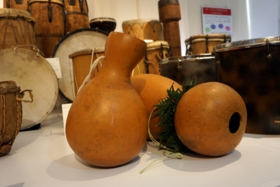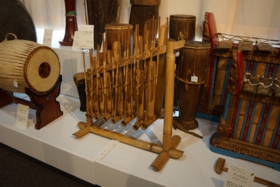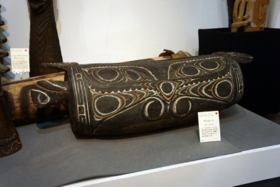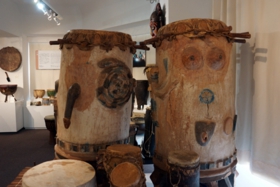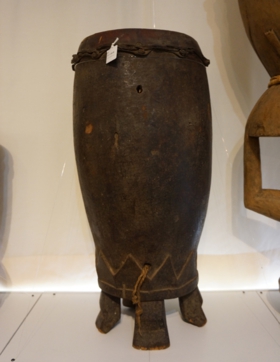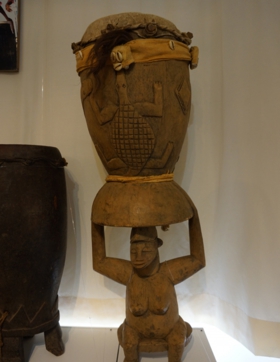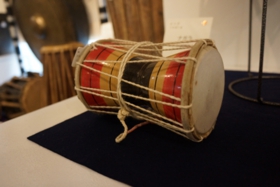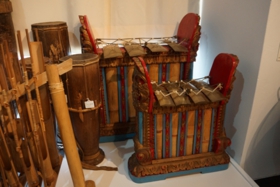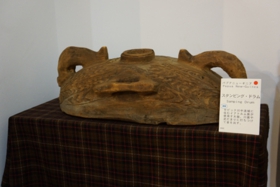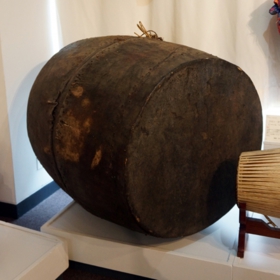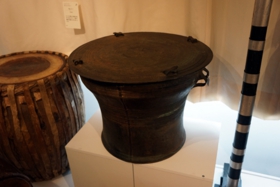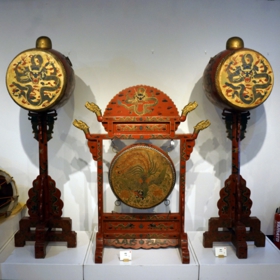The Drum Museum, located on the 4th floor of Nishi-asakusa Store, Miyamoto Unosuke Shoten, opened in 1988 as a museum where "visitors can actually touch and beat drums" that were collected from all over the world by Unosuke Miyamoto, a president, who wanted to make visitors feel familiar to those drums. Approximately 900 drums from all over the world and more than 3,000 documents and audiovisual materials are stored in the museum. It is one of the greatest drum museums in the world. The mission of the museum is to spread the enjoyment and fabulousness of beating drums.
When we visited the museum, 200-250 drums around the world were exhibited. Japanese drums are displayed in the center, drums from the Latin-American countries on the right side from the entrance, African drums on the left, and a variety of drums from the Middle East, Europe and Asia at the back of the room. Labels are put on captions of exhibits. Although instruments with red labels cannot be touched, instruments with clef labels can be touched and played.

Drum Museum (the 4th floor of Nishi-asakusa Store)

Visitors can touch a variety of drums and percussion instruments around the world and hear the notes. The museum is always filled with joyful sound. Many tourists from abroad stroll in the Asakusa area, and visit the museum to enjoy seeing and beating various drums from all over the world.

Gourd drums (Ivory Coast)
In Ivory Coast, drums are made of gourds, and antelope skin is used for drumheads. People dangle those drums from their necks, and beat them with their hands. Visitors can also beat this drum.

In a Kabuki performance, falling snow is represented by beating a drum from its edges to center.

A roar of waves is represented by weakly beating a drum with long and thin sticks for a while and strongly beat it once after a short interval.
In the past, there were many Kabuki theaters in the Asakusa area. When this drum's drumhead was replaced by Miyamoto Unosuke Shoten, a Kabuki theater's name "Ichimura-za" was discovered inside of the body. The Saruwaka town (formerly famous for Kabuki theaters) association still exists in this area. This drum has been designated as a cultural property of Taito City, and preserved in the Drum Museum.
Ipu Heke (United States)
Drums made of gourds used for accompaniments to the hula in Hawaii
Angklung (Indonesia)
Bamboo tubes are attached to a frame. A player holds it with his hands or on his arm, and shake it to make sound.
Garamut (Papua New Guinea)
A slit drum made by the Iatmul people
This drum is made from a hollowed-out log and played by striking it with poles. A Japanese drum is played by bringing raised sticks down on it, but Garamut is by poking it. When it is played, it is put on a board so that its sound becomes milder. Decorations on its surface represent spirits of their ancestors.
Drums from Dahomey (Benin)
These drums are used at marriage ceremonies. They are now actually used at marriage ceremonies in Benin. The two drums have a male genital organ and a female genital organ, respectively, which represent prayer for conjugal harmony, longevity and healthy babies.
A drum made by the Senufo people (Ivory Coast)
A drum made by the Senufo people (Ivory Coast)
Shapes of some drums vary according to uses and genders of users. For example, the Senufo people use drums at coming-of-age ceremonies. The upper part of this drum (top) represents a hippopotamus, that is, a strong man. The lower part represents a woman who carries a pack on her head.
Damru (India)
A player holds a body of Damru, and beat its head with an attached ball. It is said that its shape, which is narrow in the middle, has influenced shapes of small and big hand drums in Japan.
Gender (Indonesia)
This instrument is used for the gamelan music. A player beats the bronze bars with wooden sticks.
Stamping drum(Papua New Guinea)
A drum made by the Ede people (Vietnam)
It is covered with Elephant skin. Actually, there are a small number of drums covered with Elephant skin in Vietnam. It is said that this drum was made by a prestigious family. Hairs on drumhead skin are totally removed in Japan, but some drums in other countries are covered with skin with hairs.
Copper drums (Myanmar)
Generally, drums' bodies are covered with skin, but there are some exceptions. These drums are covered with metal. They are called "Frog Drum."
Kenko and Kako Drums (China)
The right and left drums are called "Kenko," and the center is "Kako." Dragons depicted on the drumhead of Kenko have five claws. The patterns depicted on these drums are exclusive for emperors and empresses in the Qing dynasty, so it is seemed that these drums were actually used in the dynasty. Generally, drumheads are riveted in Asian countries. It is a characteristic common across East Asia, including Japan.

In a Kabuki performance, falling snow is represented by beating a drum from its edges to center.

A roar of waves is represented by weakly beating a drum with long and thin sticks for a while and strongly beat it once after a short interval.
In the past, there were many Kabuki theaters in the Asakusa area. When this drum's drumhead was replaced by Miyamoto Unosuke Shoten, a Kabuki theater's name "Ichimura-za" was discovered inside of the body. The Saruwaka town (formerly famous for Kabuki theaters) association still exists in this area. This drum has been designated as a cultural property of Taito City, and preserved in the Drum Museum.














